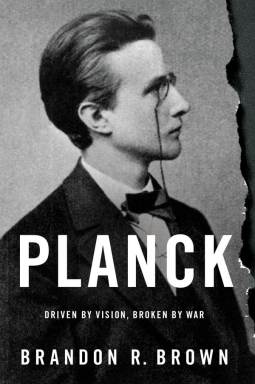Postcards From Asgard by Amalia Dillin

Thjalfi is a minor character from the Prose Edda (and an even more minor character in the Poetic Edda) but Dillin took the character and definitely made him her own. She turns him into a charming farmhand who surprisingly turned out to be a deep thinker and loyal. Not to mention he sounds easy on the eyes.
Gwen is a hard working farm-girl who is as stubborn as the goats she milks. She’s completely independent and comfortable with her lifestyle tending to her goats, horses, chickens, and cats.
The two characters as a couple are very well matched. Thjalfi is very giving and Gwen is very stubborn which makes for an interesting pair. The romance starts off tentative but turns sure and sweet.
The goats, Blender and Masher, sealed the deal for me. They are horrible, demonic monstrosities that add so much humor to the story and actions cause emotional situations between the characters that I couldn’t help but love the beasts.
Dillin also incorporated a small guide to pronounce Icelandic/Norse words without it sounding like an information dump! Information dumps are hard for authors to avoid when need-to-know information has to make the story and somehow still be seamless.
Overall, Postcards From Asgard defiantly satisfied my love for Norse Mythology and in a modern, non-superhero fashion! I recommend this to anyone who is a fan of the old Norse myths and wouldn’t mind hearing them with a twist, or for paranormal romance readers in general.
Review: Chaos Theory by M. Evonne Dobson

“My life is a high-wire act looking down at the world, and the people below are like distant data sets. Well, those data sets are leaping up to bite me in the butt, forcing me to fall smack into the chaos below.”
Kami’s character is a teen genius aiming for MIT. She doesn’t relate to people and often gives them nicknames of her own devising. For her science project she gathers scraps of meaningful pieces of her life (concert tickets, letters) and stuffs them in her locker with a color coded marble for her “chaos theory” experiment. Everyday she opens her locker she literally waits for another ball to drop. One small change can significantly effect the future (think Butterfly Effect) and Kami struggles to grasp how she can define that in just a locker.
Enter: Daniel. He’s known around school as the boy who killed his sister with drugs. When Kami accidentally gets involved with him, something just doesn’t add up in her logical mind and she can’t let go of the mystery behind the boy.
Sandy is Kami’s best friend, probably the only one who knows and understands every side of her. Sandy’s theatre work and gossip network makes her a more than competent part of the team.
Sam is Sandy’s boyfriend and a reporter for the newspaper. His inquisitive nature and sleuthing skills of his own help him join in the ranks.
But (thank goodness) this isn’t a story about teenagers trying to take down drug dealers on their own. Kami’s little group work with Daniel’s handler, Detective Bob, to figure out the truth behind Julia’s death and the drugs found with her.
As the story moves on the chaos theory experiment becomes less about the locker and expands into the real world as Kami herself is gaining more knowledge of people as humans and not just data points. The group learns how each small and seemingly unimportant change in Julia’s life ultimately contributed to the end.
Overall, I suggest this book to anyone who likes young adult mystery/crime novels with a small mixture of romance. I’m most defiantly waiting for another Kami File.
Book Review: My Heart and Other Black Holes

“Sometimes I wonder if my heart is like a black hole-it’s so dense that there’s no room for light, but that doesn’t mean it can’t still suck me in.”
Aysel is a physics nerd. Roman is a basketball star. What they have in common is they both want to die and seek out a suicide partner online.
Aysel’s character is what you would picture of a suicidal teen. Her depression forces her to see the worst; her mother’s frown is because of Aysel, people talk behind her back waiting for her to turn into her father, her half-sister living as if Aysel didn’t exist. As she starts to regain hope you slowly start to see behind the veil of her depression that maybe the world doesn’t hate her as much as she thought.
Roman’s character is different. He is a former basketball star and shows no outward sign of being depressed until Aysel looks closer and sees herself in him. His depression comes in the form of guilt over an accident that happen almost a year before the story takes place, in which he is sure is his fault.
My physics-nerd half is a little disappointed that Aysel, being a physics-nerd herself, didn’t mention the titled “Black Holes” as much as I would have liked. There was plenty of talk of kinetic and potential energies, but only once (maybe a couple of times) when a black hole was mentioned as a comparison to depression.
The individual emotions of the two main characters is what makes this book stand out. One character trying to find a connection and another trying to disconnect; both feeling different emotions and having different reasonings but coming to the same conclusion. It’s a slap in the face to Aysel (as well as the reader) that anyone can be suffering from depression no matter how well put together they seem on the surface.
I would have liked more interactions with minor characters. I’m a sucker for good minor characters and there was so much potential in Aysel’s half-sister and Roman’s former friends to be good minor characters.
Overall, I would recommend My Heart and Other Black Holes to anyone who likes realistic fiction with light romance and heavy on the psychological side. Definitely an author to keep an eye on.
Book Review: Shadow Study by Maria V. Snyder

There’s no question that Maria V. Snyder knows how to magical fantasy works. Shadow Study takes the readers back into the fantastic countries of Ixia and Sitia who have a shaky peace treaty in place. The countries are still wary of each other despite the now open boarders.
Valek is torn between his forever commitment to the Commander and his love for his heart mate, Yelena. What was really amazing in this book is that we get to see so much more of Valek’s story; including his training as an assassin, how he met the Commander, and his assassination of the king. He’s still the sleek, sexy, and completely deadly assassin we know from the previous books, but in this book we also get to see a more human side of Valek.
Yelena has been independent since we’ve met her in Poison Study, but that independency has always included her magic. In Shadow Study she has to relearn how the world works without her magic while being the target of unknown assassins. She struggles, but she’s still ultimately that tough woman that managed to steal the heart of an assassin.
We don’t see much of Ari and Janco, but we do have Janco’s POV chapters with a very interesting new character! Onora is paired with Janco on his mission into Sitia, much to Janco’s amusement and Onora’s annoyance. Janco is the same lovable character as ever, fighting with rhymes and pouting to get his way. Letting him have his own POV chapters was a fantastic idea.
Onora is a new character introduced in this series. She’s a young, half-trained assassin that’s after Valek’s job. She’s headstrong and pushes to get things done her way, but she’s very clever and I’m looking forward to how her character continues to develop (WITH Janco, maybe? I’d ship it.)
The story is told from three POV’s; Yelena, Valek, and Janco with Yelena’s POV being in first person. This was such an excellent choice! Each character where in their own story on their own mission until it all came together in the end. It was like reading three stories that slowly merged together.
Magic wasn’t dominate in this book, but it is still a key factor. The action here lies with assassins.
Overall, I greatly recommend Shadow Study to fans of romantic fantasy. You will need to read the Study series first, but you can make do without reading the Glass series.
Book Review: Red Queen by Victoria Aveyard
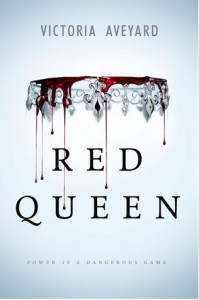
“It’s our nature. We destroy. It’s the constant of our kind. No matter the color of blood, man will always fall.”
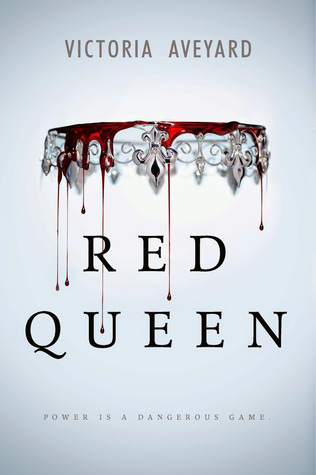
Diving straight in, the first 60-70% of this book drove me completely nuts. It was slow and full of inconsistencies and eye-roll worthy ideas. I don’t have a clear picture of the world because it was never really described. The people travel in boats, transport, airships, and the prince even “invented” the motorcycle, but is it modern?
Steampunkish? Do they run on gas? Electricity? Guess I’ll have to ask a tech from the tech city. Yes, there’s a city FULL of techies. You would think they could control the world, but they seem content to work until they die in an overly polluted city even though they could probably invent weapons that could rival the powers of the Silver-bloods. You know, since they have tvs, security cameras (thousands of them, apparently), and, get this, FORCE FIELDS.
I wish I had make-up like Mare’s. In order to hide that she’s a Red-blood, she has to wear make-up that makes her skin lighter to match the Silver’s. Apparently it lasts all day and is sweat/water-proof. The author really missed an opportunity for an “uh-oh, almost got caught” moment with the rain.
The Silver-blooded powers seem to be unlimited. We keep being told that they are limited, but we are never shown-especially with the queen. They also only show the super-powered Silvers and not the Silvers with smaller powers. Maybe that’s being saved for another book, but it wouldn’t have hurt to see it while it was being mentioned.
What aggravated me the most is the key point to the story, what is supposed to hold the story together, doesn’t make a lick of sense. Mare is a Red with powers, forced to pretend to be a long-lost Silver of a noble family, but the story the queen concocted was absolute rubbish. The queen would have to kill everyone in Mare’s village to keep her “secret” from getting out, and even then you’d have to be completely stupid to believe it.
Mare herself isn’t exactly the brightest crayon in the box, either. She gets great advice from plenty of people along the way but chooses to ignore them and, oopsie, causes trouble because of it. It’s really hard to follow Mare, much less like her.
The other characters are very flat. You don’t really get to know much about their characteristics or given a hint of their personality until the end of the book. The king, who should have a major roll as the ruler, is just a place card and hardly has any part in the story at all.
Overall, Red Queen was a disappointing read for me, but if you enjoy ya-fantasy and can overlook the inconsistencies, you might find something in it.
Book Review: Edward Scissorhands Volume 1: Parts Unknown by Kate Leth

The artwork in this comic reminds me of the contrasts between the Beetlejuice movie and 90’s cartoon. It has an air of the original character, but is different enough to become a character of its own.
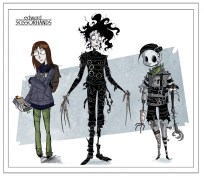

The coloring keeps to the movie, while Edward is in his blacks with grayish skin, the rest of this comic book world is bright and cheery further separating his character from the norm.
The plot is interesting- skipping into the future when Kim is dead and we are introduced her daughter and granddaughter. Meg fights her mother over her grandmother’s story of Edward- believing that Edward in fact was a savior and not a murderer while her mother thought Kim delusional. The story put a rift between both mother/daughter pairs and made a great side point. I think the story would have been more substantial if Kim was still in the picture, but placed in a home. It would increase tension but it would also allow Meg a future mentor, and a sweet reunion for Edward.
Eli, an abandoned experiment Edward discovers, is the key to this volume. The creature discovers he is missing an important piece of himself but can’t quite figure out what. This part of the story is so Burton-esque I’m half surprised that The Man himself didn’t have a hand in writing it! I really wish the author would have focused a little less on mother/daughter relationship and more on the soul-searching creature.
Meg’s character doesn’t really fit the mold she’s supposed to fill. Her character lives for her grandmother’s (Kim) stories of Edward, but she doesn’t seem the fairytale/adventure type of character. There was nothing to indicate that she ever dreamed of meeting Edward or truly believed Kim except her arguments with her mother.
Edward is almost picture perfect. He hold’s that shy and unsureness that makes his character adorable and innocent. I do wish that the author showed more emotion on Edward when he learns who Meg is.
Overall, Edward Scissorhands: Parts Unknown is a delightful visit to an old friend well worth the read. I recommend to fans of the movie and newcomers alike.
Book Review: Silence by Deborah Lytton

“Someday Broadway. The thought flutters in the darkness. A golden butterfly seeking escape. It frees itself. Flies away. I watch Someday Broadway disappear. And I close my eyes.”
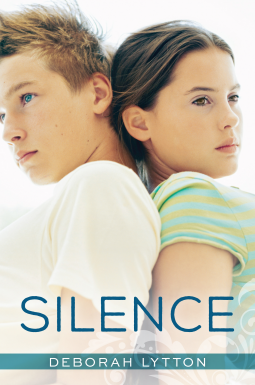
Stella is shy, but shines when she’s singing on stage. Her dream is “Someday Broadway” while she avoids falling in love like her mother. Hayden stutters, but is a master at the piano. He is cloaked in mystery and slow to reveal himself to the readers. He’s very artistic and keeps to himself. An accident leaves Stella deaf and Hayden’s slow speech allows her to easily read his lips. With a tragic past of his own, he only allows himself 17 days to show her how beautiful the world could be even without sound.
Confession time! I spent most of this book pretending Stella was seventeen instead of fifteen like she’s supposed to be according to the novel. Her characteristics and dialog (not to mention her interactions and her parent’s reactions to the seventeen year old Hayden) do not fit that of a fifteen year old girl.
It is a very clean romance, which is very refreshing and fit the characters perfectly. But at times it did get sickeningly sweet and left the characters in a gooey mess. The plot ran smoothly along, almost too smoothly. There were no big bumps along the way to throw the characters off track and create a deeper plot. There were plenty of past reveals, but nothing that shook the relationship between the characters enough for there to be any real drama.
Overall, Silence is a good Young Adult romance that I recommend to anyone looking for a nice, clean romance for a fresh chance of pace.
Book Review: Planck: Driven by Vision, Broken by War by Brandon R. Brown

“He’d seen his colleagues, including Lise, driven from the Fatherland. He’d seen the ever-advancing thresher of new laws, first limiting, then persecuting, then gathering Jews along with other Nazi targets. He must have known of the inhuman trains, even if he didn’t know their destination.”
This book focuses not only on Max Planck’s contributions to the scientific community, but his contribution to his his county, family, friends, and fellow scientists during one of the most harrowing times of Germany’s history. Planck had jewish friends and was often mocked as being a “white jew” himself, his standing as a credible physicist taking dire blows because of his association with the jews. But through it all, he also did not give up on his fatherland.
The book is well written- the author including several quotes about Planck from his friends and former students. It also includes Planck’s involvement with other physicists including Albert Einstein. The author is even comical at times, comparing Planck’s “Phantom Problems” to “The Ultimate Question” in Hitchhiker’s Guide to the Galaxy.
Overall, Planck was an intriguing read with insightful information on the life of the physicist. I recommend this book to fans of autobiographies or anyone looking to dig just a little deeper into the life of Planck.
Book Review: Victorian Fairy Tales by Michael Newton
“Fairy tale stands for all that the Gradgrinds and the Bounderbys of the world would reject; in place of fact, calculation, and the ratio, they propose fancy and mystery; in place of a mathematical and analytical understanding, they offer affection, intuition, and strangeness.”

You won’t find any Disney-fied stories in this collection of classic Victorian tales. Think you know the story of The Three Bears? I bet you don’t remember an old woman jumping out the window and possibly breaking her neck at the end.
It’s a simple anthology of a good verity of Victorian fairy tales, with a long introduction that explains the differences between primitive oral fairy tales and Victorian fairy tales. Newton even explains the styles certain authors use for their fairy tales and how they contrast from others.
Overall Victorian Fairy Tales was a good read that I recommend to anyone who enjoys fairy tales or short stories.
My Heart and Other Black Holes
 “Sometimes I wonder if my heart is like a black hole-it’s so dense that there’s no room for light, but that doesn’t mean it can’t still suck me in.”
“Sometimes I wonder if my heart is like a black hole-it’s so dense that there’s no room for light, but that doesn’t mean it can’t still suck me in.”Aysel is a physics nerd. Roman is a basketball star. What they have in common is they both want to die and seek out a suicide partner online.
Aysel’s character is what you would picture of a suicidal teen. Her depression forces her to see the worst; her mother’s frown is because of Aysel, people talk behind her back waiting for her to turn into her father, her half-sister living as if Aysel didn’t exist. As she starts to regain hope you slowly start to see behind the veil of her depression that maybe the world doesn't hate her as much as she thought.
Roman’s character is different. He is a former basketball star and shows no outward sign of being depressed until Aysel looks closer and sees herself in him. His depression comes in the form of guilt over an accident that happen almost a year before the story takes place, in which he is sure is his fault.
My physics-nerd half is a little disappointed that Aysel, being a physics-nerd herself, didn’t mention the titled “Black Holes” as much as I would have liked. There was plenty of talk of kinetic and potential energies, but only once (maybe a couple of times) when a black hole was mentioned as a comparison to depression.
The individual emotions of the two main characters is what makes this book stand out. One character trying to find a connection and another trying to disconnect; both feeling different emotions and having different reasonings but coming to the same conclusion. It’s a slap in the face to Aysel (as well as the reader) that anyone can be suffering from depression no matter how well put together they seem on the surface.
I would have liked more interactions with minor characters. I’m a sucker for good minor characters and there was so much potential in Aysel’s half-sister and Roman’s former friends to be good minor characters.
Overall, I would recommend My Heart and Other Black Holes to anyone who likes realistic fiction with light romance and heavy on the psychological side. Definitely an author to keep an eye on.
www.readingbifrost.com
Chaos Theory
 “My life is a high-wire act looking down at the world, and the people below are like distant data sets. Well, those data sets are leaping up to bite me in the butt, forcing me to fall smack into the chaos below.”
“My life is a high-wire act looking down at the world, and the people below are like distant data sets. Well, those data sets are leaping up to bite me in the butt, forcing me to fall smack into the chaos below.”Kami’s character is a teen genius aiming for MIT. She doesn’t relate to people and often gives them nicknames of her own devising. For her science project she gathers scraps of meaningful pieces of her life (concert tickets, letters) and stuffs them in her locker with a color coded marble for her “chaos theory” experiment. Everyday she opens her locker she literally waits for another ball to drop. One small change can significantly effect the future (think Butterfly Effect) and Kami struggles to grasp how she can define that in just a locker.
Enter: Daniel. He’s known around school as the boy who killed his sister with drugs. When Kami accidentally gets involved with him, something just doesn’t add up in her logical mind and she can’t let go of the mystery behind the boy.
Sandy is Kami’s best friend, probably the only one who knows and understands every side of her. Sandy’s theatre work and gossip network makes her a more than competent part of the team.
Sam is Sandy’s boyfriend and a reporter for the newspaper. His inquisitive nature and sleuthing skills of his own help him join in the ranks.
But (thank goodness) this isn’t a story about teenagers trying to take down drug dealers on their own. Kami’s little group work with Daniel’s handler, Detective Bob, to figure out the truth behind Julia’s death and the drugs found with her.
As the story moves on the chaos theory experiment becomes less about the locker and expands into the real world as Kami herself is gaining more knowledge of people as humans and not just data points. The group learns how each small and seemingly unimportant change in Julia’s life ultimately contributed to the end.
Overall, I suggest this book to anyone who likes young adult mystery/crime novels with a small mixture of romance. I’m most defiantly waiting for another Kami File.
Postcards from Asgard
 Thjalfi is a minor character from the Prose Edda (and an even more minor character in the Poetic Edda) but Dillin took the character and definitely made him her own. She turns him into a charming farmhand who surprisingly turned out to be a deep thinker and loyal. Not to mention he sounds easy on the eyes.
Thjalfi is a minor character from the Prose Edda (and an even more minor character in the Poetic Edda) but Dillin took the character and definitely made him her own. She turns him into a charming farmhand who surprisingly turned out to be a deep thinker and loyal. Not to mention he sounds easy on the eyes. Gwen is a hard working farm-girl who is as stubborn as the goats she milks. She’s completely independent and comfortable with her lifestyle tending to her goats, horses, chickens, and cats.
The two characters as a couple are very well matched. Thjalfi is very giving and Gwen is very stubborn which makes for an interesting pair. The romance starts off tentative but turns sure and sweet.
The goats, Blender and Masher, sealed the deal for me. They are horrible, demonic monstrosities that add so much humor to the story and actions cause emotional situations between the characters that I couldn’t help but love the beasts.
Dillin also incorporated a small guide to pronounce Icelandic/Norse words without it sounding like an information dump! Information dumps are hard for authors to avoid when need-to-know information has to make the story and somehow still be seamless.
Overall, Postcards From Asgard defiantly satisfied my love for Norse Mythology and in a modern, non-superhero fashion! I recommend this to anyone who is a fan of the old Norse myths and wouldn’t mind hearing them with a twist, or for paranormal romance readers in general.
www.readingbifrost.com
Playlist for the Dead

“Apparently I wasn’t the only one who was finding people surprising these days. It made me wonder whether everyone had these secret lives, these aspects of themselves that didn’t match who they seemed to be.”
Where to begin with this? For starters, don’t worry about the music. I did listen to some of the songs but it’s really not necessary to follow the story. The music has more to do with Sam and Hayden’s relationship than the actual storyline. The songs on the playlist are meant to help Sam understand why Hayden committed suicide, but after listening to it several times the songs only confuse him.
During the story Sam finds that Hayden had other friends he didn’t know about and secrets he was keeping even from his best friend. The bullying everyone was aware of, but slowly though-out the book Sam is introduced to new characters and new perspectives of the fate filled night at the party.
What I really loved about this book is that it’s psychologically light, but layered with the emotions those that are left behind face: guilt, blame, anger, sadness, loneliness, hopelessness. It could be possible that everyone and no one is to blame for Hayden’s death. The narrative by Sam also made me able to really understand his feelings at any point in the story. Just how a passage was written would leave me just as frustrated or confused as Sam. Bravo.
What I didn’t like is, like in so many other YA novels, the complete lack of parent interaction. It seems like a go-to fix-it for YA novelists if you need parents out of the way, then the kid has a no-show dad and mother who is either a) a waitress at a 24/7 dinner or b) a nurse with odd hours.
Overall, Playlist for the Dead is a great realistic fiction novel from this debut author. I recommend it for anyone who likes psychological YA fiction that’s on the tragic side.
Thirteen Reasons Why
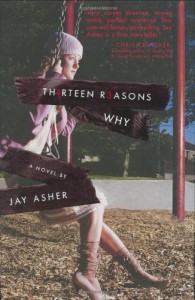 “Looking back, I stopped writing in my notebook when I stopped wanting to know myself anymore…
“Looking back, I stopped writing in my notebook when I stopped wanting to know myself anymore…If you hear a song that makes you cry and you don’t want to cry anymore, you don’t listen to that song anymore.
But you can’t get away from yourself. You can’t decide not to see yourself anymore. You can’t decide to turn off the noise in your head.”
First of all, just to make things clear, this is a book; fiction, and absolutely not meant to be used as a counseling device or guide for suicidal teens.
Hannah had thirteen reasons why she decided to commit suicide. As the new girl in school it was hard enough making new friends, then the rumors started. Slowly her high school life turned into her personal nightmare and Hannah recorded seven cassette tapes that acts as her suicide note; each story she tells explains a reason why she made her final decision.
Hannah explains through the tapes that these aren’t the only reasons, but it’s the story that connects the most people together and affected her the most. As the story moves on you’ll see a snowball effect; one persons actions leads to actions by another, then later circles around again to make the ball bigger and bigger. Hannah shows how “harmless” but hurtful pranks can start to define a student in high school and how labels are regarded higher than truth.
Clay is a typical nice guy, but that doesn’t necessarily make him a good guy. He is the main narrator of the book who had a crush on Hannah and. He receives the tapes and spends an entire afternoon and night listening to each tape from Hannah and even going to some of the places she marked on a map.
The story as a whole isn’t about Hannah and suicide. It’s more about individuals and reactions. Some of the characters’ reactions to receiving the tapes and knowing they had part in Hannah’s dead, even small, caused them to break down. Other characters that had more prominent roles in her death refused to see what they had done wrong.
The biggest issue is that the side characters fall flat. They’re not even enough personality for me to really care for them as individuals.
Overall, Thirteen Reasons Why is a good YA novel that hits tough issues. I would recommend for anyone who likes realistic YA that doesn’t dive too deep.
Poisoned Apple
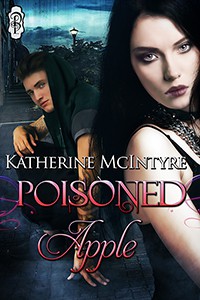 “All of the sudden, things she’d never given a second thought to mattered so much. The comfortable bed she’d slept in for as long as she could remember, the brass dresser lamp she and her mom had picked out at the thrift shop, even the stack of old paintings she’d saved from when she had time for art. All of those things meant more than she’d realized.”
“All of the sudden, things she’d never given a second thought to mattered so much. The comfortable bed she’d slept in for as long as she could remember, the brass dresser lamp she and her mom had picked out at the thrift shop, even the stack of old paintings she’d saved from when she had time for art. All of those things meant more than she’d realized.”Neve is a self-proclaimed “damaged girl”. Why she doesn’t have any school-friends isn’t exactly clear, but she’s kicked out as soon as she turns eighteen and her real problems begin (even though she kind of predicted this was going to happen in the first place) when she finds herself with no place to go. Her character isn’t very trusting but is in a situation where she has to rely on the kindness of a stranger or sleep on the streets.
Brendan seems to be the guy that picks all the wrong girls- Stacy being the last on what could be a long list. His first reaction to Neve is that she’s just another girl looking for guy willing to pay for her expenses. After being set right, he invites Neve to crash on his couch for a week. That week ends up being the longest of Neve’s life as secrets of her family and past are reviled to her and slowly bring her crashing down.
The real problem I have with this story is that it lacks character depth and has discrepancies in the plot. It is a short novella so the characters have to develop and stand out rather quickly. By the end Neve just started to gain my interest while I was still overlooking Brendan. The biggest discrepancy is even though Neve absolutely knew her stepmother was going to kick her out on her eighteenth birthday, the resourceful girl did nothing to prepare for that day beforehand. At all.
The best part of the novella were the diner rats- a group of mostly guys that seem to have nothing better to do in the afternoons than to hang out at an all night diner to talk, study, etc. I would have liked a little more focus on Neve’s interaction with the group.
Overall, Poisoned Apple is an okay novella that I would recommend to YA readers looking for a quick, light read.
www.readingbifrost.com
The Strange Library
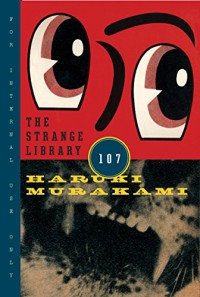 ‘“If all they did was lend out knowledge for free, what would the payoff be for them?”
‘“If all they did was lend out knowledge for free, what would the payoff be for them?”“But that doesn’t give them the right to saw off the tops of people’s heads and eat their brains. Don’t you think that’s going a bit too far?’”
If you haven’t ever read a story by Murakami before, he’s odd. Very odd. I’m trying my best to review this without giving away any spoilers at all for those who just want to read the story and for those who like to dig for the deeper meanings.
That being said, The Strange Library is a short story presented in a lone book. The book itself is odd, the cover has to be flipped open and has very strange vintage Japanese illustrations to match the story. Everything about the story seems simple and straightforward- not digging deep into characters or plots- adding a richness and dreamlike quality to the story.
But, if you take it to the true Murakami level of reading (we’re talking deep philosophy here) then the reader just might see that the story really revolves around the boy, his pet bird, his mother, and death.
Now, throughout the story the boy was worried about his pet bird. But his bird was already dead, and his mother was dying. He knew the fear of pain and loss in death, and kept to himself in the library (which is why his mother didn’t mind when he finally returned home late, she understood his troubled mind, and also why his new shoes meant so much to him). The design of the book also played a part in how to read the story. The last page where the boy spoke of his mother’s death was written small- the boy lifeless and alone.
Overall The Strange Library was a fabulously odd short short story whether you’re just looking for a quick read or something you can sink your teeth into. I’d suggest getting a hardcopy instead of an ebook for this one just because the Chip Kidd design does add a lot to the story.
www.readingbifrost.com




